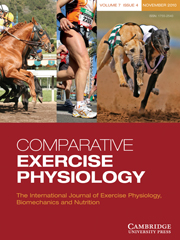Crossref Citations
This article has been cited by the following publications. This list is generated based on data provided by
Crossref.
Piccione, Giuseppe
Messina, Vanessa
Bazzano, Marilena
Giannetto, Claudia
and
Fazio, Francesco
2013.
Heart Rate, Net Cost of Transport, and Metabolic Power in Horse Subjected to Different Physical Exercises.
Journal of Equine Veterinary Science,
Vol. 33,
Issue. 8,
p.
586.
Birn-Jeffery, Aleksandra V.
and
Higham, Timothy E.
2014.
The Scaling of Uphill and Downhill Locomotion in Legged Animals.
Integrative and Comparative Biology,
Vol. 54,
Issue. 6,
p.
1159.
Brouillet, N.
Jarlot, B.
Pillard, P.
Bertucci, W.
and
Viguier, E.
2015.
Preliminary comparative study of two accelerometers performances for evaluation of dorsoventral movement in trotting horse.
Computer Methods in Biomechanics and Biomedical Engineering,
Vol. 18,
Issue. sup1,
p.
1892.
Birn-Jeffery, Aleksandra V.
and
Higham, Timothy E.
2016.
Geckos decouple fore- and hind limb kinematics in response to changes in incline.
Frontiers in Zoology,
Vol. 13,
Issue. 1,
Lage, J.
Fonseca, M. G.
de Barros, G. G. M.
Feringer-Júnior, W. H.
Pereira, G. T.
and
Ferraz, G. C.
2017.
Workload of official contests, net cost of transport, and metabolic power of Mangalarga Marchador horses of marcha batida or picada gaits1.
Journal of Animal Science,
Vol. 95,
Issue. 6,
p.
2488.
Ohmura, Hajime
Mukai, Kazutaka
Takahashi, Toshiyuki
Aida, Hiroko
and
Jones, James H.
2017.
Cardiorespiratory function in Thoroughbreds during locomotion on a treadmill at an incline or decline.
American Journal of Veterinary Research,
Vol. 78,
Issue. 3,
p.
340.
Hunka, M.M.
Lima, L.C.F.
Souza, L.A.
Silva, C.J.F.L.
Silva, E.R.R.
Manso, H.E.C.C.C.
and
Filho, H.C. Manso
2017.
Heart rate and velocity in Vaquejada horses during field tests.
Comparative Exercise Physiology,
Vol. 13,
Issue. 1,
p.
25.
Gerald, Gary W.
Thompson, Moriah M.
Levine, Todd D.
and
Wrinn, Kerri M.
2017.
Interactive effects of leg autotomy and incline on locomotor performance and kinematics of the cellar spider, Pholcus manueli.
Ecology and Evolution,
Vol. 7,
Issue. 17,
p.
6729.
Kopec, Nadia L.
Williams, Jane M.
and
Tabor, Gillian F.
2018.
Kinematic analysis of the thoracic limb of healthy dogs during descending stair and ramp exercises.
American Journal of Veterinary Research,
Vol. 79,
Issue. 1,
p.
33.
Parkes, Rebecca S. V.
Weller, Renate
Pfau, Thilo
and
Witte, Thomas H.
2019.
The Effect of Training on Stride Duration in a Cohort of Two-Year-Old and Three-Year-Old Thoroughbred Racehorses.
Animals,
Vol. 9,
Issue. 7,
p.
466.
Coelho, Clarisse S.
Sodre, Ticiane D. R. P.
Sousa, Lara N.
Siqueira, Renata F.
Manso Filho, Helio C.
Aragona, Francesca
and
Fazio, Francesco
2021.
How Much Energy Vaquejada Horses Spend in a Field Simulation Test?.
Animals,
Vol. 11,
Issue. 12,
p.
3421.
Jahn, Miki
and
Seebacher, Frank
2022.
Variations in cost of transport and their ecological consequences: a review.
Journal of Experimental Biology,
Vol. 225,
Issue. 15,
Feringer-Júnior, Walter Heinz
de Carvalho, Júlia Ribeiro Garcia
Moranza, Henriette Gellert
de Almeida, Maria Luiza Mendes
Lemos, Eliana Gertrudes Macedo
Soares, Otávio Augusto Brioschi
Ribeiro, Gesiane
and
de Camargo Ferraz, Guilherme
2022.
Cost of transport, but not gluteus medius and red blood cells monocarboxylate-transporters density differentiated Brazilian Sport Horses at two performance levels.
Research in Veterinary Science,
Vol. 143,
Issue. ,
p.
20.
Arias, Adrien A.
and
Azizi, Emanuel
2023.
Modulation of limb mechanics in alligators moving across varying grades.
Journal of Experimental Biology,
Vol. 226,
Issue. 22,
Siqueira, R.F.
Teixeira, M.S.
Perez, F.P.
and
Gulart, L.S.
2023.
Effect of lunging exercise program with Pessoa training aid on cardiac physical conditioning predictors in adult horses.
Arquivo Brasileiro de Medicina Veterinária e Zootecnia,
Vol. 75,
Issue. 4,
p.
545.
Coelho, Clarisse
Vintem, Carolina
Silva, Ana Sofia
Santos, Catarina
Santos, Ana Margarida
Leite, Anderson
Souza, Vinicius
Siqueira, Renata
Filho, Helio Cordeiro Manso
and
Simões, Joana
2025.
A 6‐Week Training Protocol Reduces Energy Consumption in Young Lusitano Horses Used in Dressage.
Journal of Animal Physiology and Animal Nutrition,
Chen, Kaixiang
Zhang, Rui
Dong, Wenchao
Pang, Hao
Li, Guoyu
and
Wen, Lige
2025.
Kinematic mechanisms of coordinated fore and hind hoof movements for stability enhancement and energy efficiency in reindeer long-distance migration.
Polar Biology,
Vol. 48,
Issue. 3,
Simões, J.
Santos, A.M.
Santos, C.
Silva, A.S.
Vintém, C.
Fonseca, J.
and
Coelho, C.
2025.
Biological markers and metabolic energy indexes of show jumping horses during a field exercise test in Portugal.
Journal of Equine Veterinary Science,
Vol. 151,
Issue. ,
p.
105634.

